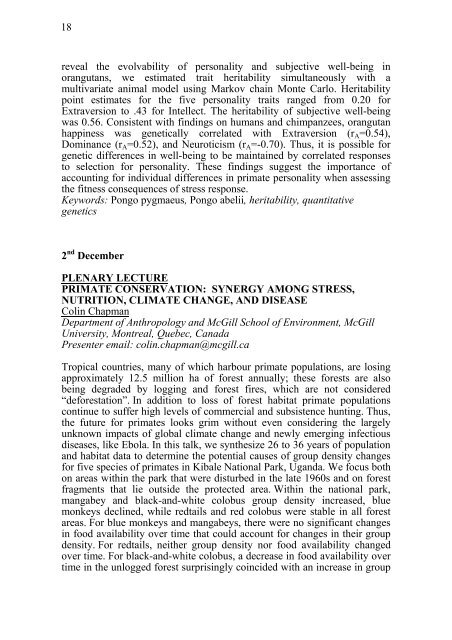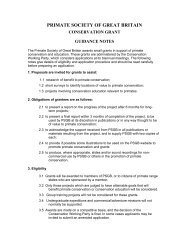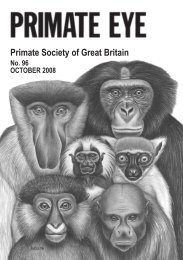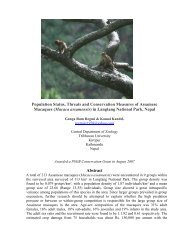2009 Vol 99.pdf (2.45mb) - Primate Society of Great Britain
2009 Vol 99.pdf (2.45mb) - Primate Society of Great Britain
2009 Vol 99.pdf (2.45mb) - Primate Society of Great Britain
You also want an ePaper? Increase the reach of your titles
YUMPU automatically turns print PDFs into web optimized ePapers that Google loves.
18<br />
reveal the evolvability <strong>of</strong> personality and subjective well-being in<br />
orangutans, we estimated trait heritability simultaneously with a<br />
multivariate animal model using Markov chain Monte Carlo. Heritability<br />
point estimates for the five personality traits ranged from 0.20 for<br />
Extraversion to .43 for Intellect. The heritability <strong>of</strong> subjective well-being<br />
was 0.56. Consistent with findings on humans and chimpanzees, orangutan<br />
happiness was genetically correlated with Extraversion (r A =0.54),<br />
Dominance (r A =0.52), and Neuroticism (r A =-0.70). Thus, it is possible for<br />
genetic differences in well-being to be maintained by correlated responses<br />
to selection for personality. These findings suggest the importance <strong>of</strong><br />
accounting for individual differences in primate personality when assessing<br />
the fitness consequences <strong>of</strong> stress response.<br />
Keywords: Pongo pygmaeus, Pongo abelii, heritability, quantitative<br />
genetics<br />
2 nd December<br />
PLENARY LECTURE<br />
PRIMATE CONSERVATION: SYNERGY AMONG STRESS,<br />
NUTRITION, CLIMATE CHANGE, AND DISEASE<br />
Colin Chapman<br />
Department <strong>of</strong> Anthropology and McGill School <strong>of</strong> Environment, McGill<br />
University, Montreal, Quebec, Canada<br />
Presenter email: colin.chapman@mcgill.ca<br />
Tropical countries, many <strong>of</strong> which harbour primate populations, are losing<br />
approximately 12.5 million ha <strong>of</strong> forest annually; these forests are also<br />
being degraded by logging and forest fires, which are not considered<br />
“deforestation”. In addition to loss <strong>of</strong> forest habitat primate populations<br />
continue to suffer high levels <strong>of</strong> commercial and subsistence hunting. Thus,<br />
the future for primates looks grim without even considering the largely<br />
unknown impacts <strong>of</strong> global climate change and newly emerging infectious<br />
diseases, like Ebola. In this talk, we synthesize 26 to 36 years <strong>of</strong> population<br />
and habitat data to determine the potential causes <strong>of</strong> group density changes<br />
for five species <strong>of</strong> primates in Kibale National Park, Uganda. We focus both<br />
on areas within the park that were disturbed in the late 1960s and on forest<br />
fragments that lie outside the protected area. Within the national park,<br />
mangabey and black-and-white colobus group density increased, blue<br />
monkeys declined, while redtails and red colobus were stable in all forest<br />
areas. For blue monkeys and mangabeys, there were no significant changes<br />
in food availability over time that could account for changes in their group<br />
density. For redtails, neither group density nor food availability changed<br />
over time. For black-and-white colobus, a decrease in food availability over<br />
time in the unlogged forest surprisingly coincided with an increase in group






